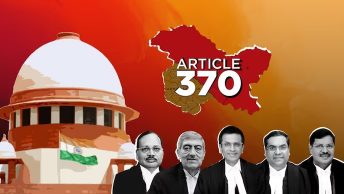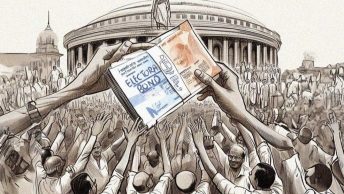This article is the second part of a two-part series on the 103rd amendment which provides for a maximum of ten percent reservation to the economically weaker sections of citizens. You may find the first part here.
Article 16 (4): Not a basic feature
If we look at the text of article 16 (1), it says that,
“16. Equality of opportunity in matters of public employment. —
(1) There shall be equality of opportunity for all citizens in matters relating to employment or appointment to any office under the State.”
I have already discussed in the last section, that the Court in NM Thomas had held that article 16 (4) is not an exception, but rather a facet of article 16 (1) and furthers what the clause (1) holds. In the words of Justice Mathew in Thomas,
“78. I agree that Article 16(4) is capable of being interpreted as an exception to Article 16(1) if the equality of opportunity visualized in Article 16(1) is a sterile one, geared to the concept of numerical equality which takes no account of the social, economic, educational background of the members of Scheduled Castes and scheduled tribes. If equality of opportunity guaranteed under Article 16(1) means effective material equality, then Article 16(4) is not an exception to Article 16(1). It is only an emphatic way of putting the extent to which equality of opportunity could be carried viz., even up to the point of making reservation.”
The court clearly held that if article 16 (1) is understood to consist of material equality, then article 16 (4) cannot be understood to be an exception to article 16 (1). And if that is the case, the court then said that even making of special provisions (to the extent of providing for reservations) is justified and is just an emphatic way of holding what is already existing in article 16 (1). In the case of current Amendment as well, if we borrow the reading provided to art 16 (1) in Thomas, it is nowhere precluded that the current Amendment (in the form of newly inducted clause 6) could not be another possible manifestation of art 16 (1). Professor Surendranath has already argued elsewhere how providing for reservations to the economically weaker sections can be justified as furthering the spirit of substantive equality within the Indian Constitution.
Therefore, that being said, I don’t find it difficult to argue that this new Amendment as well furthers the substantive equality of article 16 (1) but this time for economically weaker sections. The Court in Sawhney had held that under article 16 (4), “backward class of citizens” would mean educationally and socially backward class of citizens. The court read into the wordings of article 16 (4) to say that “backward class” would mean socially and educationally backward classes. This time, through the Amendment, the state is not prevented from providing one more, though new and unique reading to art 16 (1) for the economically backward class of citizens and include it in the Constitution as art 16 (6).
Given the fact that neither art 16 (1) nor article 16 (4) is a part of the basic structure of the Constitution, the sixth clause of art 16 is not obliged to pass the test of social and educational backwardness [as read by the Court for article 16 (4)].
Equality: A basic feature of the Constitution
Out of the challenges that I have mentioned above, thus far, neither of them is capable enough to shake the constitutional foundations of the Amendment. In the foregoing part, I have already discussed the first instance where the court had to answer the questions of basic structure for a reservation related amendment. The second instance where the court was to examine the validity of a reservation-amendment was in the case Ashoka Kumar Thakur. The Parliament, in that case, by way of the 93rd Amendment Act, had introduced clause (5) to article 15. The challenge was made on the ground that the amendment had violated ‘equality’ as a basic feature and hence, must be declared to be invalid. While upholding the amendment and holding equality a part of the basic structure, Chief Justice Balakrishnan held that equality is a multi-colored concept and is not limited to one single definition.
He read equality as an expansive concept and held that the larger principles of equality as stated in articles 14, 15, and 16 are the elements of the basic structure of the Constitution and not any specific or particular strand from any of these articles. The broader ideals underlying the equality code in entirety, therefore, must be understood as a part of the basic structure. He said,
“If any constitutional amendment is made which moderately abridges or alters the equality principle or the principles under Article 19(1)(g), it cannot be said that it violates the basic structure of the Constitution. If such a principle is (sic not) accepted, our Constitution would not be able to adapt itself to the changing conditions of a dynamic human society. Therefore, the plea raised by the petitioners’ counsel that the present Constitution (Ninety-third Amendment) Act, 2005 alters the basic structure of the Constitution is of no force.”
For the court, as the amendment does not completely take away the concept of equality in itself in so far as the state maintained and aided educational institutions are concerned, it is not dehors the basic structure.
In that light, the only possible attack to the Amendment is its ability to satisfy equality as a basic feature of the Constitution. As per paragraphs 146, 147, and 148 of Sawhney judgment, the Court laid down the idea of equality as a basic feature of the Constitution. While underlining the importance of reservations for offsetting the historical wrongs, the Court held that it will be equality amongst the equals which will have to be considered. Therefore, even if the 103rd Amendment Act, 2019 was to be tested on the basic feature of equality, some challenges such as that of arbitrariness, reasonable classification, or, the 50% rule itself as an extension of the equality principle might creep in.
The fear of the Amendment being unable to satisfy the arbitrariness aspect of ‘equality’ as basic structure, it will be pre-mature consideration. In my opinion, since the Amendment does not introduce any economic limit into the constitutional text, the question of arbitrariness does not arise. This is because the question of arbitrariness will become relevant only at the point, when the state brings in some law/notification/order to bring into force art 15 (6) and introduces some kind of economic limitations, etc. In that case as well, that law would have to be tested on Part III (in general) and arbitrariness under art 14 of the Constitution (in specific). This is because by virtue of article 13 (2), any law has to satisfy the vires of Part III and not of the basic structure (which is exclusively for the amendments to the Constitution).
Arbitrariness, in our case, cannot be accrued to the Amendment at all, as from the reasons mentioned in the foregoing parts, by having the 10% reservation of seats for the economically weaker sections, it does not vitiate the tests of equality as a basic feature.
The other (and rather more interesting) question is that of 50% rule being an extension of the equality principle itself. For the Petitioner, it is a reasonable assumption to draw that ever since the Court opined this 50% cap in MR Balaji, the principle has been affirmed and upheld in almost every question related to reservation and hence, by the boon of this practice, it has become a basic feature of the equality. Further, any departure from this rule would damage the principle of equality substantially. If a strong reliance is placed on the practice, it might be one of the conclusions to draw, but I believe that this is simply a stretch and should not be understood to be a part of the principle of equality. This is primarily because of couple of reasons.
Firstly, there has not been any judicial pronouncement to the effect, which has held that 50% ceiling limit, in any of its forms (either as an aspect of the equality principle, or that of adequate representation principle) is a part of the basic structure of the Constitution. All the judgments, from time to time, have given high credence to the 50% rule, but neither of them has held that in an absence of this limit, ‘equality’ as a basic feature of the Constitution will not be enjoyed.
Secondly, when the 50% ceiling was introduced in MR Balaji, the court had said that “speaking generally and in a broad way, a special provision should be less than 50%.” This limit was reached after considering multiple social factors. Ever since Balaji, the demographics would have certainly been changed and hence, there is no stopping for the court to upgrade/downgrade this 50% ceiling limit. All that may be required is a bench of more than 9 judges, so that the position held in Indra Sawhney can be overruled. On a side note and to that extent, even Sawhney had not envisaged the 50% rule as a strict mark and kept open the possibilities of creating exceptions. Irrespective of this, since this 50% limit itself is alterable, the same cannot be held as a basic feature of the equality principle.
This is clearly because, as understood from the practice, an essential requirement for something to be considered a basic feature of the Constitution is that it should be so basic and essential to the Constitution that altering the same would result in the Constitution losing its identity. However, as I have discussed in detail above, the scope left by Indra Sawhney indicates that the 50% requirement is not strict and there could be cases where an exception could be made to the 50% rule. A change in the 50% rule does not create any havoc on the equality code of the Constitution.
If one of the most dearly held essentials of a basic feature principle itself is alterable/subject to change, it is tough to agree that simply owing to a wider practice, any changes with the same will damage the equality as a larger concept. Also, while dissenting in Devadasan (and referring to Balaji), Subbarao J. had explicitly said that this ceiling was not a rule of law. He further said that,
“The expression used in the observations viz. “generally” and “broadly”, shows that the observations were intended only to be a workable guide but not an inflexible rule of law even in the case of admissions to colleges.”
Conclusion
After surveying the judicial position on reservations, what emerges is the fact that there do not exist any perilous threats to the constitutionality of the Amendment. The life of the Amendment, for the purposes of duration in the Constitutional text is long, so to say. However, the only downside will be that of implementation. The task of defining economically weaker section will be mired with subjectivity and would vary as per the political dispensation implementing the same. Besides this, challenges with regard to production of fake income certificates by those who would want to be beneficiaries of a scheme like this will be huge, and difficult to curb. While the constitutional adjudication could be simpler, the Herculean task would be for the writ courts to plug the implementation leakages.
The author wishes to thank Dr Anup Surendranath and Dr Mohsin Alam for their discussion on the basic structure doctrine.






